Media | Articles
This Time Attack Viper Is a “Bear on Bath Salts”
When Kevin Burke learned that his YouTube exploits had opened the door to a fully-funded season of time attack, he felt like he’d finally arrived. When he was told that the car he would drive was the one he once posted on the wall of his college dorm, he had to pinch himself. It all sounded like a fairy tale. Getting to drive and develop a 2010 Viper ACR Voodoo Edition in one of Southern California’s most competitive time attack series was a dream come true.
Fantasy Foray
Even though Torco, his sponsor, was footing the bill, Burke had obligations outside of rockstar driver duty. In addition to turning the wheel, Burke was responsible for determining which class would suit the car and Torco’s budget. That’s not as straightforward as it sounds—there are plenty of variables in play that can impact how well a car will perform in a given class. Ultimately, Burke elected to run the Viper with Toyo RR tires in NASA’s TT1 class. Even if they had to add ballast to meet the minimum weight requirement of 3,750 pounds, they still stood a chance of being competitive, since not every car in these fields boasts over 600 horsepower.

Turned out, competitive was an understatement. Burke dominated his first event, and soon the complaints came rolling in. “People accused me of cheating; saying the car was lighter than I had claimed. Nothing that heavy on medium-grip tires should be that fast through the slow sections, they believed.”
Burke’s initial success didn’t come without some fine-tuning, particularly to his driving style. The heavy, high-horsepower Viper required a different approach to the one he’d grown accustomed to. He’d cut his teeth in a Honda S2000, and that high-revving, lightweight roadster was a good bit different than the beast he was now piloting.
The Viper, despite being a surprisingly precise weapon for its size, was not as chuckable as the S2000. It almost had a split personality; surefooted and confidence-inspiring in the fast sections, but a bit clumsy in the slower stuff. That was partially explained by Dodge’s factory aero package, which the company says nets over a thousand pounds of downforce at 150 mph. The lower the speed, though, the more that the big car became reliant on mechanical grip.
Marketplace
Buy and sell classics with confidence
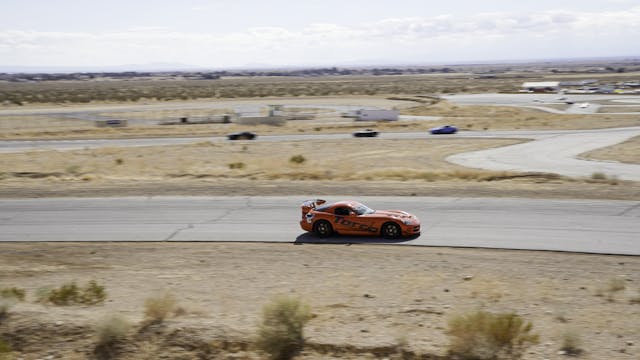
He learned quite quickly that he’d have to drive the car in the point-and-shoot fashion through the second and third-gear sections. Even if it meant sacrificing some entry speed to ensure the car, doing what he could to straighten the Viper a tenth of a second earlier allowed him to deploy that power more efficiently. The sooner he applied the throttle, the better the delta on his lap timer got.
Despite figuring out how to make the most of the car as it sat, its handling was still a challenge. Burke continued to find success, but the reality was that the Viper was in poor form until the final event of that season. There, he began to understand why it was trying to bite his head off.
“We tried to change the alignment a few times, but nothing worked. It was just a handful everywhere we went. At the last event of the season, fellow Viper driver Shawn Romig showed me how Dodge had set the car up. After we made those changes, I could get in harmony with the car, but it was still far from perfect. It was finally semi-stable at corner entry, but it still had too much off-throttle understeer to commit completely.”
Seeing the effect of a few tweaks, Kevin had a hard time focusing on his day job over the following weeks. Daydreaming about improving on the halo car he’d fallen in love with was now a legitimate time sink. He could only look forward to the promise of the next season—until he received the call he hoped would never come. Despite their frugality and careful planning, the Torco coffers were empty at the end of the season. There would be no time attack in ’22.
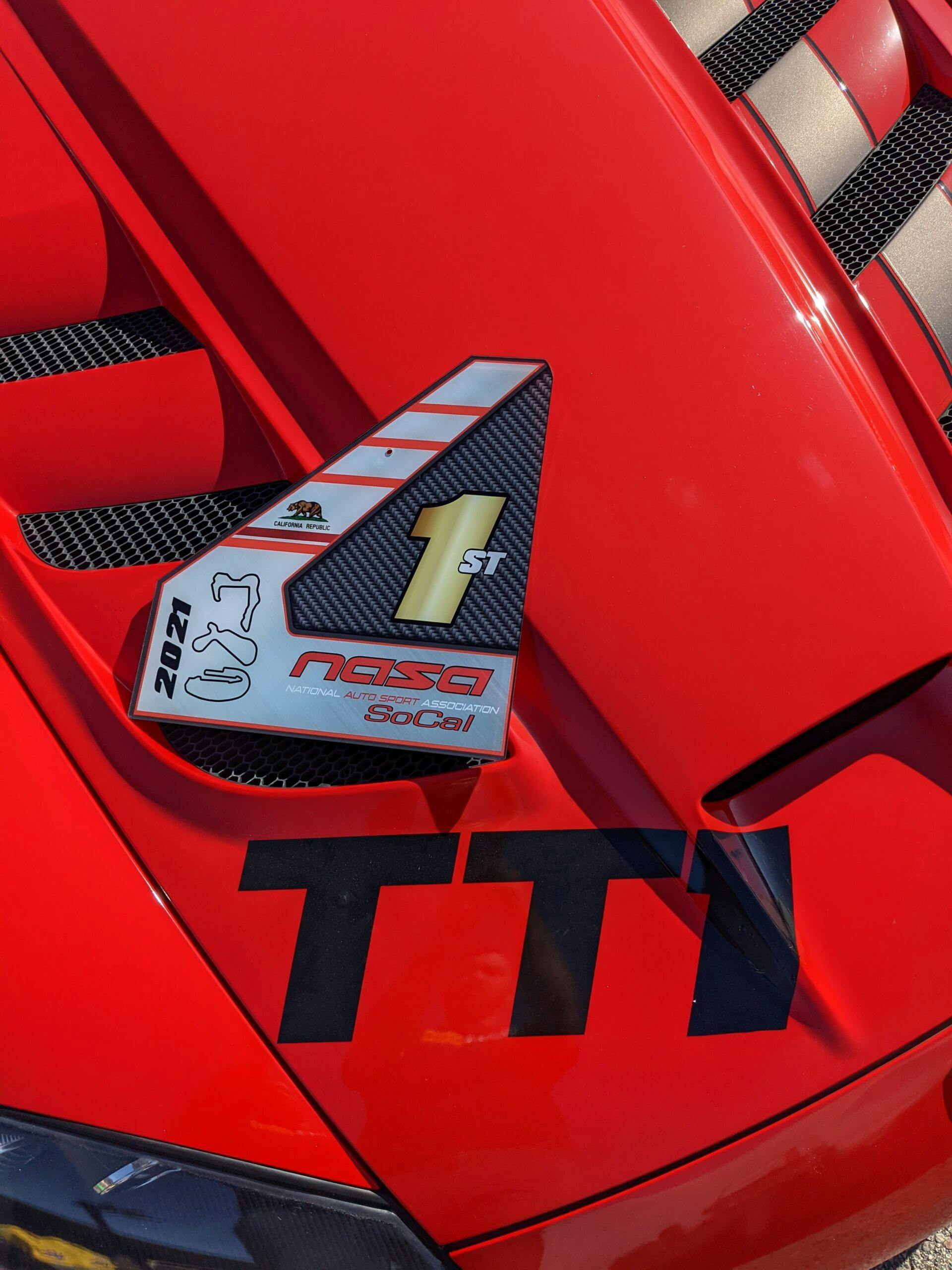
The car’s owner offered to sell the car to Kevin, but the asking price was too steep. After that offer came and went, Kevin kicked himself for not taking out a loan. And so the car sat for a year.
With all that frustration of not being on the track with the car he adored, Kevin didn’t hesitate when the owner reached out again and offered the car at a reduced price. This time, he’d stretch himself thin if necessary—he had to make it work.
Shedding Skin
The first order of business, stripping the car’s red wrap to reveal its original black paint, felt like the kickoff to a new chapter for Burke. Armed with a better understanding of the Viper’s flaws (and having had time to think about solutions), he had an idea which direction he had to follow. At the outset, he declared that this next iteration had to be done in an exacting fashion.
When word of his new acquisition made its way around the scene, several local shops offered free parts and support. However generous these shops were, Burke declined their offers, choosing to stay on his very specific path.

When it came to suspension upgrades, Burke pursued the right person rather than chasing what were regarded as the best top-shelf products. “I don’t shop hardware. I find a good tuner and buy whatever they know best, since they’re the ones who’ll be getting the most out of it.”
At the recommendation of suspension guru Guy Akenny, Burke replaced his KW suspension kit with a set of Penske 8300 two-way adjustable coilovers. As Burke relayed his driving impressions on the old KWs, Akenny sketched out his ideas for valving and spring rates. Akenny assembled them in-house, turned a few knobs, and then put them on his shock dyno to verify the values were met.
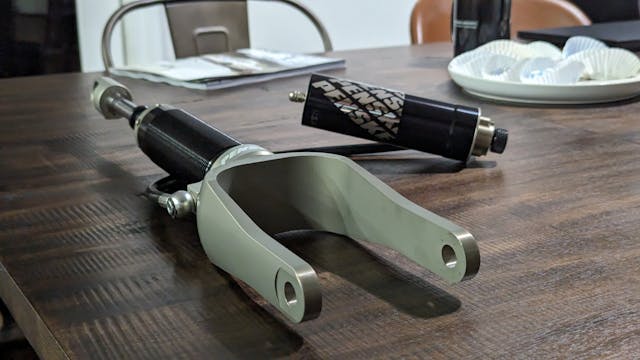
With the Penskes, he was afforded a chance to improve its on-track performance without any penalty on the street. “We went up in overall spring rate and also stiffened the fronts relative to the rear; 500/1000 to 700/1200,” he said.
It still felt soft on track, though, and springs could only account for some of that. “It was either soft bushings or a flexing chassis,” Kevin deduced. To get to the source of the Viper’s sponginess, Burke spoke with Doug Shelby Engineering, who taught him about the car’s shortcomings and offered some bushing solutions. Though he found their metal spherical option intriguing, the added NVH, maintenance, and cost dissuaded him. This car still had to be reasonably civilized on I-405 and the odd canyon road. He made a compromise and installed a set of their capable yet more-comfortable delrin bushings.
The resulting crispness and control from the shocks and bushings transformed the car. Even the first backroad blitz was encouraging; even at apace somewhere between a trot and a canter, Burke could trust the car and place it much more precisely than before.
Preliminary suspension changes made, Burke turned his attention to the drivetrain hangups—the Viper’s gearing was far from optimal for road courses. The factory transmission ratios and 3.07 final drive were better suited to Texas Mile events than a fast lap around Buttonwillow Raceway Park. “They’re ridiculous,” he shares: “Third gear goes to 125 and fourth goes to 161!”
A quick consultation with an online wheel speed calculator suggested a 3.55 final drive would keep the motor humming happily in the meat of its powerband more of the time and improve acceleration by effectively shortening every gear. The new final drive reduced each gear’s top speed by ten to fifteen miles per hour. Though this came at the cost of dropping the top speed from 187 to 175, he wasn’t concerned. At a medium-speed circuit like Buttonwillow, it’s acceleration that counts.
To optimize the drivetrain without improving power delivery in such a traction-limited car would be silly, so Burke went to address the Viper’s wheelspin issues. “I knew the diff was broken the first year, but we made do with what we had. This time around, I went to Unitrax for a Wavetrac clutch-type diff. Honestly, I wanted an OS Giken LSD, but they were backordered with no ETA. This one time, I broke with my ethos; I had to choose an imperfect part.”
Shakedown
After months of eager anticipation, the day of reckoning arrived. Kevin eagerly awoke and started the two-hour trek north for the first outing in the car since 2022. For all that the focused track mods promised, Burke wasn’t anticipating such an improvement in road manners, but Dodge’s recommended alignment, Nankang CR-S tires, and the new Penskes made his experience infinitely more enjoyable than similar drives on his prior setup. While he couldn’t call the ride comfortable, at least he wasn’t wincing any longer as he crossed over railroad tracks.
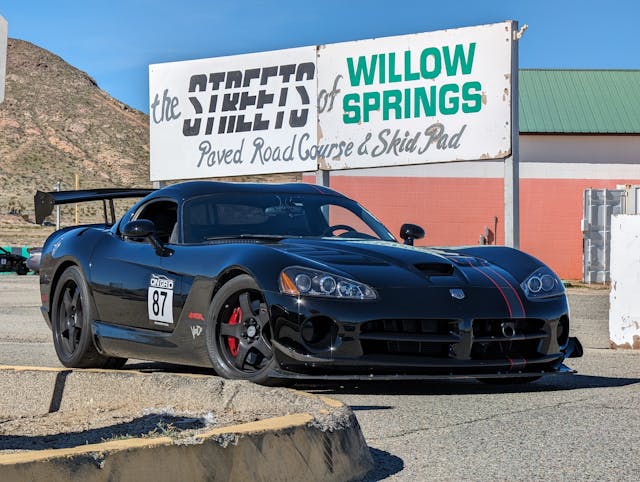
After a comfortable drive from Temecula to Streets of Willow, he could see that all he’d been striving towards was getting closer. “The spring rates felt fantastic, the car was responsive and predictable, and the way it soaked up the bumps was a little shocking. In fact, I don’t think I’ve ever driven on any shocks that were as supple as these Penskes were—out of the box, anyways. Yes, Guy turned a few knobs, but we’re still far off the right settings at this point.”
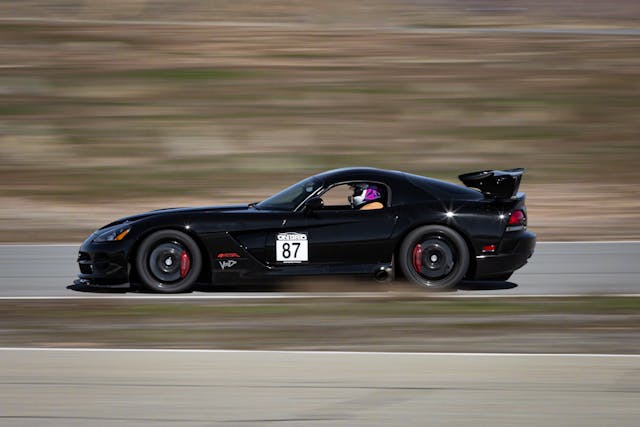
Improved body control did not mean the driving experience was made dull by any stretch. It was even more eager than before, but the Viper now turned and planted itself with a sure-footedness that Burke hadn’t previously experienced. This additional precision was a good start—the more dialed-in suspension helped mechanically address some of the Viper’s slow-corner shortcomings while providing Burke a more communicative chassis with which to work.
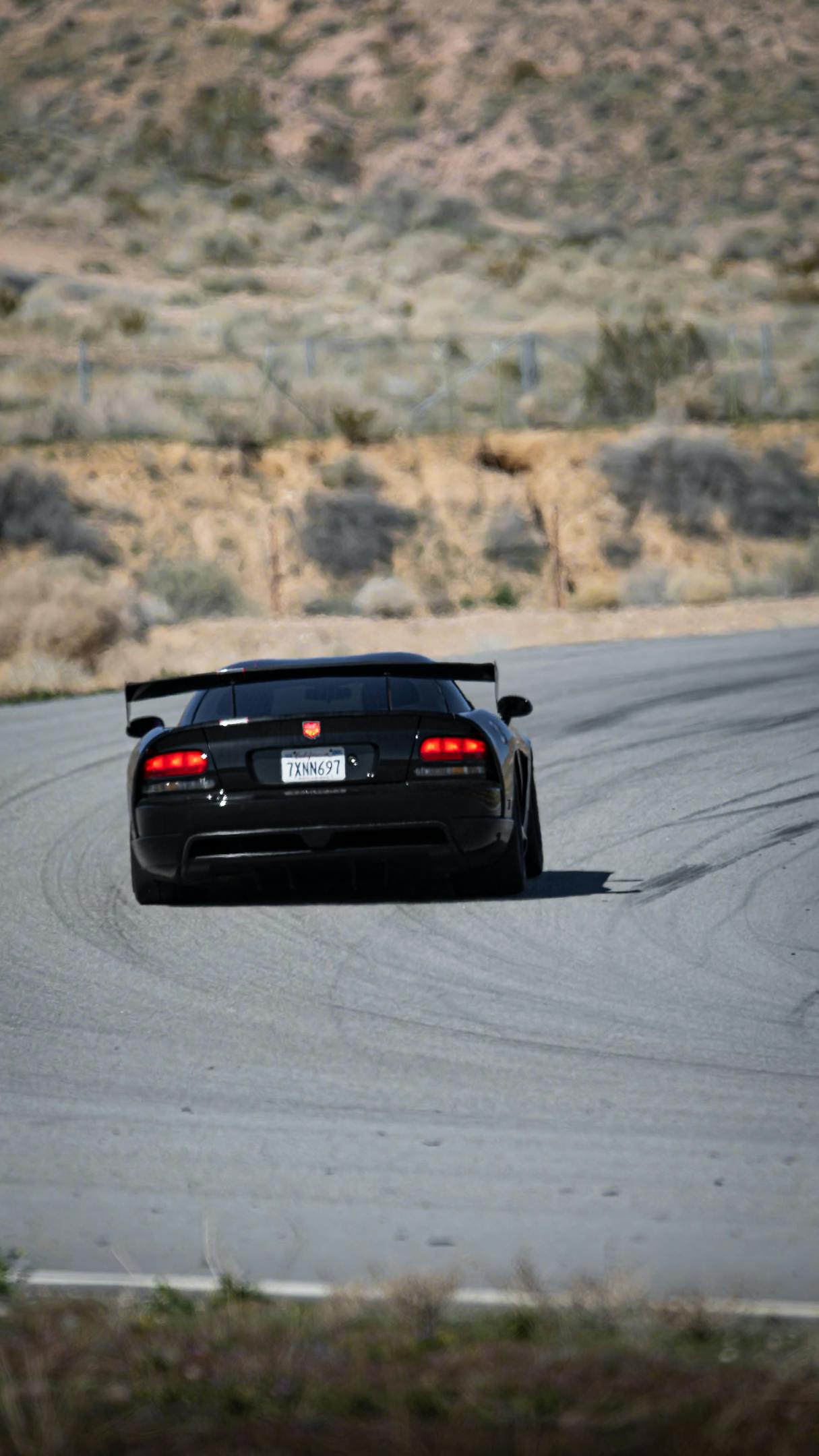
That said, the burly-chested counter steering was still there. The car remained finicky with trail-brake application, and its stump-pulling grunt available off idle requires a surgeon’s precision to apply the power without converting the rear rubber into long, black stripes on the pavement. The latter task wasn’t made any easier by the recent gearing update. On top of that, the brisk 35 degree temps on his shakedown run further compounded matters—that’s well cooler than where track tires are happy. There weren’t many sections where Burke didn’t have his hands full, as witnessed below:
Even so, Burke came away happy from the shakedown run. A 1:18 around the Streets of Willow is plenty quick, and between the temperature and a bit more dialing in, he’s confident he’ll bring his times down more. He’s eager to get the Viper to Buttonwillow—the track that he’s optimized the car for, and one where Southern Californian time attackers make a name for themselves.
Burke’s new role as a father leaves less time to develop cars, but nevertheless, from a time attack perspective, he’s in a better position now than he was in 2020. Having a knowledgeable shock builder on his side should expedite the setup process; Guy Akenny’s offered to join Burke on his next outing and help find the Penske’s potential. Plus, Torco still provides all his fluids for free. Burke’s in good hands to pursue his main aim: Beating the fifth-gen ACR’s record on street tires at Buttonwillow 13CW. That time is 1:47.7.
It’s not perfect, and it probably never will be, but that’s OK—this raw character is so much of the Viper’s charm. It’s an experience that could never be called efficient or anodyne. “It’s a bear on bath salts. I don’t know how else to explain this glorious piece of engineering. I see lots of tweaks ahead, and I’ll enjoy it even in its unfinished state. There just isn’t anything out there that’s as rewarding or challenging as this car.”
***
Check out the Hagerty Media homepage so you don’t miss a single story, or better yet, bookmark it. To get our best stories delivered right to your inbox, subscribe to our newsletters.
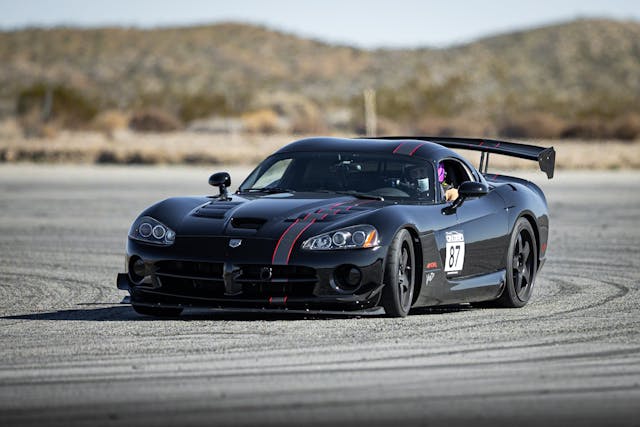






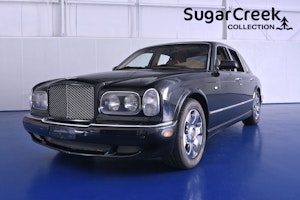











Guy ANKENY has been racing and tuning racecars since….well you weren’t born yet.
PLEASE spell his name correctly!!!
Good to see a Viper being used for what it was designed for, track time!